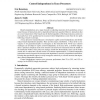Free Online Productivity Tools
i2Speak
i2Symbol
i2OCR
iTex2Img
iWeb2Print
iWeb2Shot
i2Type
iPdf2Split
iPdf2Merge
i2Bopomofo
i2Arabic
i2Style
i2Image
i2PDF
iLatex2Rtf
Sci2ools
MICRO
1999
IEEE
1999
IEEE
Control Independence in Trace Processors
Branch mispredictions are a major obstacle to exploiting instruction-level parallelism, at least in part because all instructions after a mispredicted branch are squashed. However, instructions that are control independent of the branch must be fetched regardless of the branch outcome, and do not necessarily have to be squashed and re-executed. Control independence exists when the two paths following a branch re-converge. A trace processor microarchitecture is developed to exploit control independence and thereby reduce branch misprediction penalties. There are three major contributions. 1) Trace-level re-convergence is not guaranteed despite re-convergence at the instruction-level. Novel trace selection techniques are developed to expose control independence at the trace-level. 2) Control independence's potential complexity stems from insertion and removal of instructions from the middle of the instruction window. Trace processors manage control flow hierarchically (traces are t...
| Added | 04 Aug 2010 |
| Updated | 04 Aug 2010 |
| Type | Conference |
| Year | 1999 |
| Where | MICRO |
| Authors | Eric Rotenberg, James E. Smith |
Comments (0)

